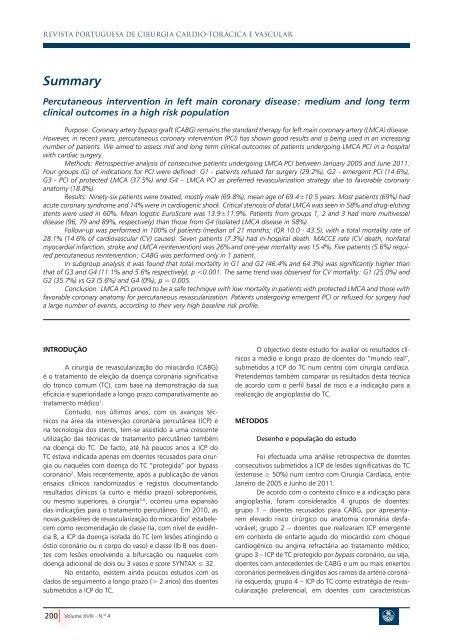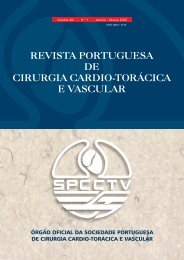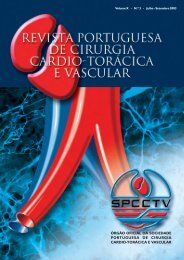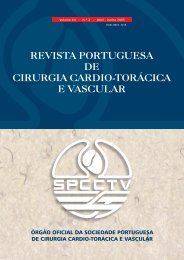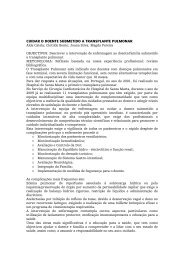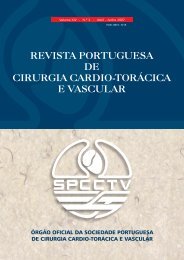Out - Dez - Spcctv.pt
Out - Dez - Spcctv.pt
Out - Dez - Spcctv.pt
You also want an ePaper? Increase the reach of your titles
YUMPU automatically turns print PDFs into web optimized ePapers that Google loves.
REVISTA PORTUGUESA DE CIRURGIA CARDIO-TOR áCICA E VASCULARSummaryPercutaneous intervention in left main coronary disease: medium and long termclinical outcomes in a high risk populationPurpose: Coronary artery bypass graft (CABG) remains the standard therapy for left main coronary artery (LMCA) disease.However, in recent years, percutaneous coronary intervention (PCI) has shown good results and is being used in an increasingnumber of patients. We aimed to assess mid and long term clinical outcomes of patients undergoing LMCA PCI in a hospitalwith cardiac surgery.Methods: Retrospective analysis of consecutive patients undergoing LMCA PCI between January 2005 and June 2011.Four groups (G) of indications for PCI were defined: G1 - patients refused for surgery (29.2%), G2 - emergent PCI (14.6%),G3 - PCI of protected LMCA (37.5%) and G4 – LMCA PCI as preferred revascularization strategy due to favorable coronaryanatomy (18.8%).Results: Ninety-six patients were treated, mostly male (69.8%), mean age of 69.4±10.5 years. Most patients (69%) hadacute coronary syndrome and 14% were in cardiogenic shock. Critical stenosis of distal LMCA was seen in 58% and drug-elutingstents were used in 60%. Mean logistic EuroScore was 13.9±11.9%. Patients from groups 1, 2 and 3 had more multivesseldisease (96, 79 and 89%, respectively) than those from G4 (isolated LMCA disease in 58%).Follow-up was performed in 100% of patients (median of 21 months; IQR 10.0 - 43.5), with a total mortality rate of28.1% (14.6% of cardiovascular (CV) causes). Seven patients (7.3%) had in-hospital death. MACCE rate (CV death, nonfatalmyocardial infarction, stroke and LMCA reintervention) was 26% and one-year mortality was 15.4%. Five patients (5.6%) requiredpercutaneous reintervention; CABG was performed only in 1 patient.In subgroup analysis it was found that total mortality in G1 and G2 (46.4% and 64.3%) was significantly higher thanthat of G3 and G4 (11.1% and 5.6% respectively), p 2 anos) dos doentessubmetidos a ICP do TC.O objectivo deste estudo foi avaliar os resultados clínicosa médio e longo prazo de doentes do “mundo real”,submetidos a ICP do TC num centro com cirurgia cardíaca.Pretendemos também comparar os resultados desta técnicade acordo com o perfil basal de risco e a indicação para arealização de angioplastia do TC.MétodosDesenho e população do estudoFoi efectuada uma análise retrospectiva de doentesconsecutivos submetidos a ICP de lesões significativas do TC(estenose ≥ 50%) num centro com Cirurgia Cardíaca, entreJaneiro de 2005 e Junho de 2011.De acordo com o contexto clínico e a indicação paraangioplastia, foram considerados 4 grupos de doentes:grupo 1 – doentes recusados para CABG, por apresentaremelevado risco cirúrgico ou anatomia coronária desfavorável;grupo 2 – doentes que realizaram ICP emergenteem contexto de enfarte agudo do miocárdio com choquecardiogénico ou angina refractária ao tratamento médico;grupo 3 – ICP de TC protegido por bypass coronário, ou seja,doentes com antecedentes de CABG e um ou mais enxertoscoronários permeáveis dirigidos aos ramos da artéria coronáriaesquerda; grupo 4 – ICP do TC como estratégia de revascularizaçãopreferencial, em doentes com características200 Volume XVIII - N.º 4


